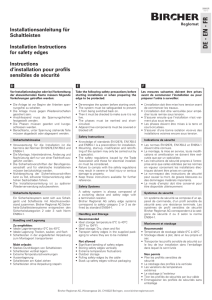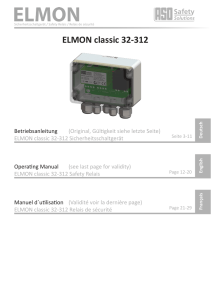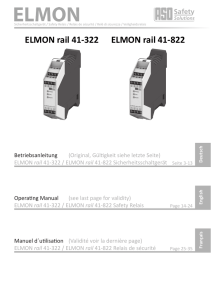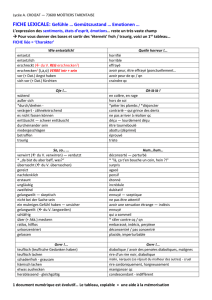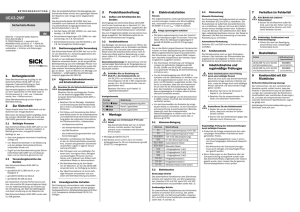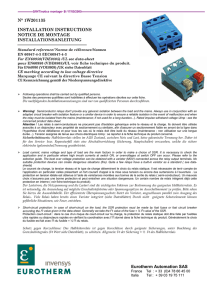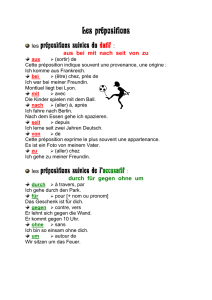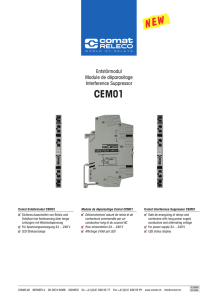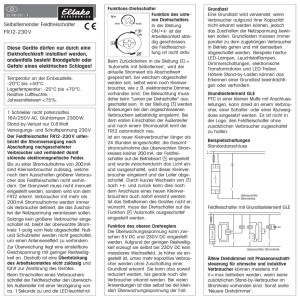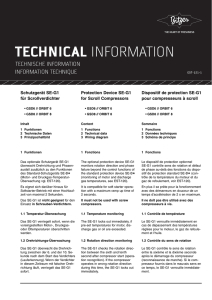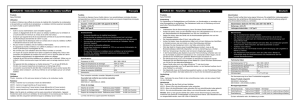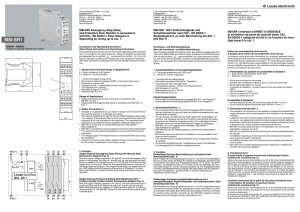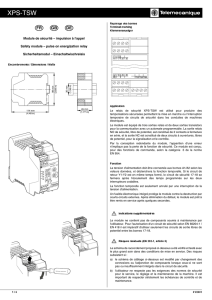ELMON rail 32-242 - ASO Safety Solutions
publicité
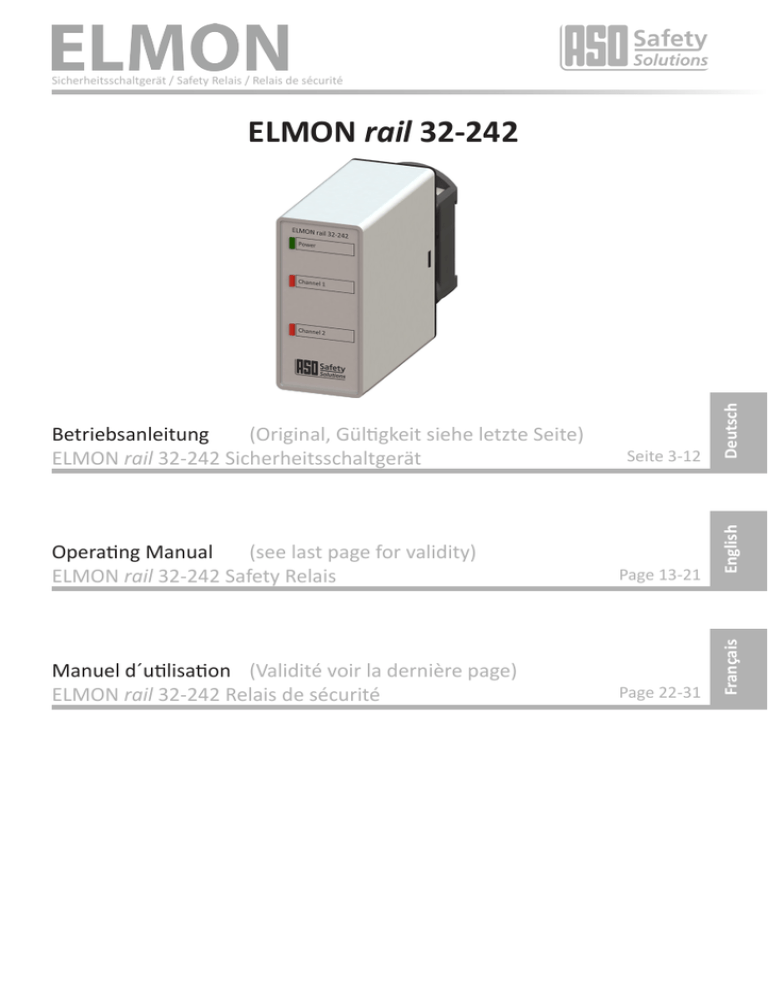
Sicherheitsschaltgerät / Safety Relais / Relais de sécurité Operating Manual (see last page for validity) ELMON rail 32-242 Safety Relais Page 13-21 Manuel d´utilisation (Validité voir la dernière page) ELMON rail 32-242 Relais de sécurité Page 22-31 English Seite 3-12 Français Betriebsanleitung (Original, Gültigkeit siehe letzte Seite) ELMON rail 32-242 Sicherheitsschaltgerät Deutsch ELMON rail 32-242 Übergabedokumentation / Documentation / Documentation de datation / Documentazione di consegna / Documentatie Anlagenbeschreibung / Description / Description du système / Descrizione impianto / ­Beschrijving van de installatie Anlagenart / Type of plant / Sorte du système / Tipo d’impianto / Type installatie Hersteller / Manufacturer / Fabricant / Produttore / Fabrikant Seriennummer / Serial number / Numéro de série / Numero di serie / Seriennummer Datum der Inbetriebnahme / Commissioning date / Date de mise en marche / Data della messa in funzione / Datum van de ingebruikname Aufstellort / Site of installation / Lieu de montage / Luogo d’installazione / Opstellingsplaats Verwendete Steuerung / Control unit / Commande utilisée / Centralina di comando adottata / Gebruikte besturing Zusatzkomponenten / Additional components / Composants supplémentaires / Componenti ­ausiliari / Bijkomende componenten Funktionsprüfung / Functional test / Contrôle de fonction / Controllo funzionale / Functiecontrole Sicherheitssensoren reagieren auf Betätigung / Safety sensor response to actuation / Le senseur de sécurité réagit à l’actionnement / Il sensore di sicurezza reagisce all’azionamento / Veiligheidssensor reageert op activering Sicherheitssensoren reagieren auf Zuleitungsunterbrechung / Safety sensor response to supply line interruption / Le senseur de sécurité réagit à l’interruption de l’alimentation / Il sensore di sicurezza reagisce all’interruzione di collegamento Veiligheidssensor reageert op onderbreking van de toevoerleiding ok ok Name der ausführenden Firma / Owner / Nom de la société exécutrice / Nome della ditta ­esecutrice / Naam van de uitvoerende firma Name des Installateurs / Installer / Nom de l’installateur / Nome dell’installatore / Naam van de installateur Datum / Date / Date / Data / Datum 2 Unterschrift / Signature / Signature / Firma / Handtekening ELMON rail 32-242 Sicherheitsschaltgerät 1.Inhaltsverzeichnis 1. Inhaltsverzeichnis . . . . . . . . . . . . . . . . . . . . . . . . . . . 3 2. Allgemeine Sicherheitsbestimmungen und ­Schutzmaßnahmen . . 4 3. Allgemeines und Funktionsbeschreibung . . . . . . . . . . . . . . 5 4. Bestimmungsgemäße Verwendung . . . . . . . . . . . . . . . . . .6 5. Anwendungsbeispiele . . . . . . . . . . . . . . . . . . . . . . . . .6 6.Geräteübersicht . . . . . . . . . . . . . . . . . . . . . . . . . . . . 7 6.1 Signalanzeigen . . . . . . . . . . . . . . . . . . . . . . . . . . . . . . . . . . . 7 6.2 Anschlussklemmen . . . . . . . . . . . . . . . . . . . . . . . . . . . . . . . . 7 7. Mechanische Befestigung . . . . . . . . . . . . . . . . . . . . . . .8 8.1Versorgungsspannung . . . . . . . . . . . . . . . . . . . . . . . . . . . . . . . 8.2 Anschluss des Signalgebers . . . . . . . . . . . . . . . . . . . . . . . . . . . . 8.3 Anschluss von mehreren Signalgebern pro Signalgeberkreis . . . . . . . . . 8.4 Anschluss Steuerstromkreise . . . . . . . . . . . . . . . . . . . . . . . . . . . Deutsch 8. Elektrischer Anschluss . . . . . . . . . . . . . . . . . . . . . . . . .8 8 8 9 9 9. Inbetriebnahme und Funktionsprüfung . . . . . . . . . . . . . . 10 10.Fehlerdiagnose . . . . . . . . . . . . . . . . . . . . . . . . . . . . 10 11.Außerbetriebnahme und Entsorgung . . . . . . . . . . . . . . . . 10 12.Technische Daten . . . . . . . . . . . . . . . . . . . . . . . . . . . 11 13.EG Konformitätserklärung . . . . . . . . . . . . . . . . . . . . . . 12 Technische und betriebsrelevante Änderungen zu den in dieser Dokumentation aufgeführten Produkten und Geräten sind jederzeit auch ohne Vorankündigung vorbehalten. 3 Sicherheitsschaltgerät Deutsch 2. Allgemeine Sicherheitsbestimmungen und Schutzmaßnahmen • Hersteller und Benutzer der Anlage / Maschine, an der die Schutzeinrichtung verwendet wird, sind dafür verantwortlich, alle geltenden Sicherheitsvorschriften und -regeln in eigener Verantwortung abzustimmen und einzuhalten. • Die Schutzeinrichtung garantiert in Verbindung mit der übergeordneten Steuerung eine funktionale Sicherheit, nicht aber die Sicherheit der gesamten Anlage / Maschine. Vor dem Einsatz des Gerätes ist deshalb eine Sicherheitsbetrachtung der gesamten Anlage / Maschine nach der Maschinenrichtlinie 2006/42/EG oder nach entsprechender Produktnorm notwendig. • Die Betriebsanleitung muss ständig am Einsatzort der Schutzeinrichtung verfügbar sein. Sie ist von jeder Person, die mit der Bedienung, Wartung oder Instandhaltung der Schutzeinrichtung beauftragt wird, gründlich zu lesen und anzuwenden. • Die Installation und Inbetriebnahme der Schutzeinrichtung darf nur durch Fachpersonal erfolgen, die mit dieser Betriebsanleitung und den geltenden Vorschriften über Arbeitssicherheit und Unfallverhütung vertraut sind. Die Hinweise in dieser Anleitung sind unbedingt zu beachten und einzuhalten. • Sicherheitsvorschriften der Elektrotechnik und der Berufsgenossenschaft sind zu beachten. • Bei Arbeiten am Schaltgerät ist dieses spannungsfrei zu schalten, auf Spannungsfreiheit zu prüfen und gegen Wiedereinschalten zu sichern. • Werden die potentialfreien Anschlüsse der Sicherheitsschaltkontakte mit einer gefährlichen Spannung fremdgespeist, ist sicherzustellen, dass diese bei Arbeiten an dem Schaltgerät ebenfalls abgeschaltet werden. • Das Schaltgerät enthält keine vom Anwender zu wartende Bauteile. Durch eigenmächtige Umbauten bzw. Reparaturen am Schaltgerät erlischt jegliche Gewährleistung und Haftung des Herstellers. • Das Schutzsystem ist in geeigneten Zeitabständen von Sachkundigen zu prüfen und in jederzeit nachvol ziehbarer Weise zu dokumentieren. Sicherheitshinweise • Das Schaltgerät ermöglicht den Betrieb an 24 V AC/DC. Der Anschluss der Betriebsspannung an die falschen Klemmen kann das Schaltgerät zerstören. • Das Schaltgerät ist in einem Schaltschrank zu montieren. • Nicht in unmittelbarer Nähe von starken Wärmequellen montieren. • Bei kapazitiven und induktiven Verbrauchern ist für eine ausreichende Schutzbeschaltung zu sorgen. Für die normenkonforme Auslegung des Sicherheitssystems muss die Anlage von Sachkundigen in geeigneten Zeitabständen auf korrekte Funktion geprüft werden. Die Prüfung muss in jederzeit nachvollziehbarer Weise dokumentiert werden. Bei Nichtbeachtung oder vorsätzlichem Missbrauch entfällt die Haftung des Herstellers. 4 ELMON rail 32-242 Sicherheitsschaltgerät 3. Allgemeines und Funktionsbeschreibung Das Gerät kann in Haushaltsumgebung und Industrieumgebung bis zu einer Höhe von 2000m über NN verwendet werden. Das Gerät darf nicht in Bereichen mit starken Temperaturwechseln betrieben werden. Rref +Ub Rel Stop Channel 1 Sensor Channel 1 Uref Rref Sensor Channel 2 +Ub Rel Uref Stop Channel 2 24V AC/DC Blockschaltbild ELMON rail 32-242 5 Deutsch Das Schaltgerät dient zur Auswertung von Signalgebern wie Sicherheitskontaktmatten, Sicherheitskontaktleisten und Sicherheitsbumpern zur Absicherung von Quetsch- und Scherstellen. An das Schaltgerät können zwei separate Signalgeberkreise angeschlossen werden, die jeweils auf einen Schaltausgang wirken. Die Ruhestromüberwachung des Signalgebers wird durch einen integrierten Abchlusswiderstand im Signalgeber ermöglicht. Das Schaltgerät überwacht diese zwei Signalgeberkreise permanent auf Betätigung oder Unterbrechung (Kabelbruch). Fließt der Soll-Ruhestrom, so sind die Ausgangsrelais angesteuert und die Schaltkontakte geschlossen. Wird der Signalgeber betätigt oder der Signalgeberstromkreis unterbrochen, öffnen die RelaisSchaltkontakte. Das Schaltgerät ist nach EN ISO 13849-1:2008 für Kategorie 3 ausgelegt. Für die Einhaltung der Kategorie 3 ist das Schaltgerät redundant und mit zwei sich gegenseitig abfragenden, zwangsgeführten Sicherheitsrelais aufgebaut. Der Überwachungszustand der Signalgeber und die angelegte Betriebsspannung werden durch LEDs angezeigt. Wenn eine Fehlermeldung vorliegt, sind alle Sicherheitsausgänge nicht aktiv. Sicherheitsschaltgerät 4. Bestimmungsgemäße Verwendung Das Schaltgerät kann seine sicherheitsrelevante Aufgabe nur erfüllen, wenn es bestimmungsgemäß eingesetzt wird. Die bestimmungsgemäße Verwendung des Schaltgerätes ist der Einsatz als Schutzeinrichtung in Verbindung mit Sicherheitskontaktmatten, Sicherheitsbumpern und Sicherheitskontaktleisten mit 8,2 kΩ Widerstand zur Ruhestromüberwachung. Ein anderer oder darüber hinausgehender Einsatz ist nicht bestimmungsgemäß. Für Schäden, die aus nicht bestimmungsgemäßen Verwendungen entstehen, übernimmt der Hersteller keine Haftung. Der Einsatz bei Sonderanwendungen bedarf einer Freigabe vom Hersteller. Eine Verwendung des Schaltgerätes in Höhen über 2000m über NN oder in explosionsgefährdeten Bereichen ist nicht zugelassen. 9 11 8,2 kΩ Signalgeber CH2 8,2 kΩ Signalgeber CH1 +24 V DC L1 L2 L3 3 10 ELMON rail 32-242 8 Out CH 2 Out CH 1 Deutsch 5. Anwendungsbeispiele 5 4 2 K1 6 K3 A1 A2 7 4 K2 A1 I1.1 I1.2 SPS Steuerung Q1.1 A2 K3 A1 K3 A2 0 V DC Schaltbilddarstellung in spannungslosem Zustand. Sensor nicht betätigt 6 L1 L2 L3 A1 A2 K1 1 3 5 K2 1 3 5 2 4 6 2 4 6 ELMON rail 32-242 Sicherheitsschaltgerät 6. Geräteübersicht 6.1 Signalanzeigen Liegt keine Fehlermeldung vor, so wird über die LED Power der Betriebszustand angezeigt (an). Bei Ausgabe einer Fehlermeldung gibt die Anzahl der ausgegebenen Pulse den Fehler an: Pulse 1 3 4 5 6 Fehlermeldung Spannungsversorgung außerhalb des gültigen Wertbereiches Ausgangssteuerung Stop Channel 1 gestört Ausgangssteuerung Stop Channel 2 gestört Datenübertragung zwischen Mikrocontroller gestört Fehler bei Testung Signaleingang (Channel 1 / Channel 2) 6.2 Anschlussklemmen 6 7 Pin 1 2 (Keine Belegung) Pin 3 11 Signaleingang Channel 1 Pin 3 10 Signaleingang Channel 2 Pin 4 5 Relais-Ausgang zur Steuerung Channel 1 Pin 6 7 Relais-Ausgang zur Steuerung Channel 2 Pin 8 9 Versorgungsspannung 24V AC/DC 5 8 4 9 3 10 11 1 2 7 Deutsch LED Power (grün) Betriebszustand (an) Fehlermeldung (Pulsausgabe) LED Channel 1 (rot) Signalgeber betätigt (an) Signalgeberstromkreis unterbrochen (blinkt schnell) Fehlerselbsthaltung (blinkt langsam) LED Channel 2 (rot) Signalgeber betätigt (an) Signalgeberstromkreis unterbrochen (blinkt schnell) Fehlerselbsthaltung (blinkt langsam) Sicherheitsschaltgerät 7. Mechanische Befestigung Das Schaltgerät muss fachgerecht befestigt werden: • • • • In einem staub- und feuchtigkeitsgeschütztem Schaltschrank oder Gehäuse. Für den Einsatz in einer Umgebung mit Verschmutzungsgrad 2. Mit einer Schutzart von mindestens IP54. Auf einer 35 mm DIN-Tragschiene nach EN 50 022. Das Schaltgerät darf nicht in unmittelbarer Nähe von starken Wärmequellen montiert werden. Die Einbaulage des Schaltgerätes ist beliebig. Deutsch Das Gerät darf nicht in Bereichen mit starken Temperaturwechseln betrieben werden. 8. Elektrischer Anschluss Der Anschluss an die falschen Klemmen kann das Schaltgerät zerstören. Leitungen, die im Freien oder außerhalb vom Schaltschrank verlegt werden, müssen entsprechend geschützt werden. Verlegung der Signalleitung darf nicht parallel zur Motorleitung oder anderen Leistungsleitungen erfolgen. Die in den „Technischen Daten“ angegebenen Grenzwerte für die Versorgungsspannung und Schaltvermögen des Relais sind zu beachten. Sorgen Sie an allen Ausgangskontakten bei kapazitiven und induktiven Lasten eine ausreichende Schutzbeschaltung. 8.1 Versorgungsspannung Als Spannungsversorgung ist an dem Klemmenpaar 8 9 24V AC/DC anzuschließen. Die Versorgungsleitung zum Schaltgerät ist mit einer passenden Sicherung zu schützen. Die Versorgungsspannung muss den Anforderungen für Schutzkleinspannung (SELV) entsprechen. 8.2 Anschluss des Signalgebers Den Signalgeber für Kanal1 an das Klemmenpaar 3 11 anschließen. Den Signalgeber für Kanal2 an das Klemmenpaar 3 10 anschließen. Sollte ein Kanal nicht genutzt werden, muss dieser mit einem 8,2 kΩ Widerstand belegt werden. 8 ELMON rail 32-242 Sicherheitsschaltgerät 8.3 Anschluss von mehreren Signalgebern pro Signalgeberkreis ASO-Signalgeber dürfen nicht parallel geschaltet werden. An dem Signalgebereingang können ein oder mehrere Signalgeber angeschlossen werden. Hierfür werden die einzelnen Signalgeber in Serie geschaltet (Bild 1). Sicherheitskontaktpuffer SENTIR bumper: Es können maximal 5 SENTIR bumper in Serie geschaltet werden. Die maximale Gesamtlänge der SENTIR bumper darf 15 m nicht überschreiten. Die Länge eines SENTIR bumper kann bis zu 3 m betragen. Die Gesamtleitungslänge der in Serie geschalteten SENTIR bumper darf 25 m nicht überschreiten. Sicherheitskontaktmatte SENTIR mat: Es können maximal 10 SENTIR mat in Serie geschaltet werden. Die maximale Gesamtfläche darf 10 m2 nicht überschreiten. Die Größe einer SENTIR mat kann bis zu 1350 x 2350 mm betragen. Die Gesamtleitungslänge der in Serie geschalteten SENTIR mat darf 25 m nicht überschreiten. Vor dem Anschließen der in Serie geschalteten Signalgeber ist es empfehlenswert, den Widerstandswert der Verschaltung auszumessen. Bei unbetätigtem Signalgeber muss der Widerstand 8,2 kΩ ± 500 Ω betragen. Ist der Signalgeber betätigt, darf der Widerstand 500 Ω nicht überschreiten. Signalgeber 1 O 2 Signalgeber „n“ Signalgeber 2 2 2 2 C Bild 1: Verschaltung mehrerer Signalgeber, hier am Beispiel Sicherheitskontaktleiste 8.4 Anschluss Steuerstromkreise An das Klemmenpaar 4, 5 ist der zu überwachende Steuerstromkreis für den Kanal1 und an das Klemmenpaar 6, 7 der entsprechende Steuerstromkreis für den Kanal2 anzuschließen. Die Steuerstromkreise sind abhängig vom Nennstrom mit einer entsprechenden Sicherung zu schützen, oder der Nennstrom auf den Steuerstromkreisen muss durch andere Maßnahmen auf den maximalen Wert begrenzt werden. Es dürfen mit dem Relaiskontakt nur Kleinspannungen (30V) geschaltet werden. Das Schalten von Niederspannungen (230V) ist nicht zulässig. 9 Deutsch Sicherheitskontaktleiste SENTIR edge: Es können maximal 5 SENTIR edge in Serie geschaltet werden. Die maximale Gesamtlänge der SENTIR edge darf 100 m nicht überschreiten. Die Länge einer SENTIR edge kann bis zu 25 m betragen. Die Gesamtleitungslänge der in Serie geschalteten SENTIR edge darf 25 m nicht überschreiten. Sicherheitsschaltgerät 9. Inbetriebnahme und Funktionsprüfung Nach entsprechendem Anschluss aller elektrischen Verbindungen und Einschalten der Versorgungsspannung muss die Anlage / Maschine auf korrekte Funktion geprüft werden. Nach erfolgreicher Inbetriebnahme sind die Sicherheitsausgänge 4, 5 und 6, 7 angesteuert (Relaiskontakte „geschlossen“). Eine Betätigung des Signalgebers bewirkt ein Öffnen der Relaiskontakte. Das Sicherheitssystem muss in geeigneten Zeitabständen von Sachkundigen geprüft werden. Die Prüfung muss in jederzeit nachvollziehbarer Weise dokumentiert werden. Die Anforderungen des Anlagen- / Maschinenherstellers sind zu berücksichtigen und einzuhalten. 10. Fehlerdiagnose Deutsch Bei korrekter Verdrahtung und Anlegen der Versorgungsspannung darf nur die grüne LED Power leuchten. Bei Aufleuchten der roten LED ist ein Fehler im System vorhanden, der sich mit Hilfe der LED eingrenzen lässt. LED Fehler grüne LED Power leuchtet nicht Versorgungsspannung fehlt, zu gering oder falsch angeschlossen. Grüne LED Power blinkt zyklisch (Pulsausgabe) Interner Fehler wird durch Anzahl Pulse angezeigt. Rote LED Channel 1 / Channel 2 leuchtet Der entsprechende Signalgeber wird als betätigt erkannt. Rote LED Channel 1 / Channel 2 blinkt schnell Signalgeberkreis unterbrochen, - Anschlüsse der entsprechenden Signalgeber überprüfen Signalgeber nicht angeschlossen, (abgequetschte Zuleitungen, brüchige Zuleitungen etc.) fehlerhaft angeschlossen - Signalgeber überprüfen * oder defekt * Fehlerbeseitigung Anschlüsse und Versorgungsspannung überprüfen: - 24 V AC/DC an Klemme 8 9 Toleranzbereich: ±10% Siehe -> Signalanzeigen - Anschlüsse der entsprechenden Signalgeber überprüfen (abgequetschte Zuleitungen, brüchige Zuleitungen etc.) - Signalgeber überprüfen * Liegt der Fehler nicht in der Verdrahtung, kann die Funktion der Elektronik durch Belegen des entsprechenden Kontaktleisten Eingangs am Schaltgerät mit einem 8,2 kΩ Widerstand überprüft werden. Arbeitet danach die Elektronik einwandfrei, muss der Signalgeber mit einem Widerstandsmessgerät überprüft werden. Hierfür muss die Verbindung des Signalgebers zum Schaltgerät aufgetrennt und mit einem Widerstandsmessgerät verbunden werden. Bei unbetätigtem Signalgeber muss der Widerstand 8,2 kΩ ±500 Ω betragen. Ist der Signalgeber betätigt, darf der Widerstand 500 Ω nicht überschreiten. 11. Außerbetriebnahme und Entsorgung Die von ASO hergestellten Produkte sind ausschließlich für den gewerblichen Gebrauch (B2B) vorgesehen. Nach Nutzungsbeendigung sind die Produkte gemäß allen örtlichen, regionalen und nationalen Vorschriften zu entsorgen. ASO nimmt die Produkte auch gern zurück und entsorgt diese ordnungsgemäß. 10 ELMON rail 32-242 Sicherheitsschaltgerät 12. Technische Daten 26 82 Anschlusswiderstand Sicherheitskontaktleisten Nominalwert Rnom 8,2 kΩ oberer Schaltwert RAO > 12,0 kΩ unterer Schaltwert RAU < 5,0 kΩ Sicherheitsrelais Nennstrom DC Nennstrom AC Mech. Lebensdauer DC-13 / 24 V / 2 A AC-15 / 30 V / 2 A >106 Betätigungen Sicherheitsrelais Sicherheitstyp M 2 A 5 x 20 Glasrohr Schaltzeiten Sicherheitsrelais Ausschaltverzögerung (Reaktionszeit) Einschaltverzögerung 84 Deutsch Versorgungsspannung Kleinspannung: UE 24 V AC/DC ±10 % IE 85 mA Imax 180mA (100ms) Leistungsaufnahme:PE-max 3 W 24 V DC PE-max 3 VA 24 V AC Sicherung Klein spannung (extern): 125mA Mittelträge Alternativ kann auch 125mA Flink verwendet werden 38 < 12 ms 500 ms (ELMON rail 32-242) 100 ms (ELMON rail 32-242 K) (Power on 700ms) Montage Stecksockel zur 35 mm DIN-Schnappschienenmontage Gehäuse 11 pol. DIN Stecksockelgehäuse mit Stecksockel für 35 mm Montageschiene Abmessungen (HxBxT) Gehäuse 82 x 38 x 84 mm Gehäuse incl. Stecksockel 82 x 38 x 110 mm Schutzart IP20 Gewicht 225 g Temperaturbereich -25°C bis +55°C Querschnitt Anschlussleitungen ein-, oder feindrähtige Leitung 0,75-1,5 mm2 Zulassungen (In Übereinstimmung mit INDUS rail 71-242) EN ISO 13849-1:2008 Kategorie 3 PL e MTTFd 170 Jahre, DC 91% Elektronik MTTFd 1616 Jahre, DC 99 % Elektromechanik B10d 1000000 / MTTFd 190 Jahre (Nop 52560) EG Baumusterprüfbescheinigung Nr.: 44 205 12 399386 Zertifikat Nr.: 44 780 12 399386 Prüfbericht Nr.: 12 205 399386-000 Alle an das Schaltgerät angeschlossenen Spannungen müssen sicher getrennte Spannungen sein! 11 Safety Relais 13. EG Konformitätserklärung Hiermit erklären wir, dass das nachfolgend bezeichnete Produkt der Baureihe: ELMON rail 32-242 (Artikelnummer 1109-0080, Format Seriennummer yymmnnnnn) ELMON rail 32-242 K Deutsch (Artikelnummer 1109-0090, Format Seriennummer yymmnnnnn) Induktive Übertragungsvorrichtung mit Sicherheitsschaltsystem zur Kombination mit Schaltleisten zur Vermeidung von Gefahren an Quetsch- und Scherstellen bei Torsystemen aufgrund ihrer Konzipierung und Bauart sowie in der von uns in Verkehr gebrachten Ausführung, den einschlägigen grundlegenden Sicherheits- und Gesundheitsanforderungen der nachfolgenden EG-Richtlinien und Normen entspricht: EG - Maschinenrichtlinie 2006/42/EG EN ISO 13849-1:2008 EN ISO 13849-2:2008 EN 61000-6-2:2005 EN 61000-6-3:2007 EG - Baumusterprüfung Notified Body 0044 TÜV NORD CERT GmbH Langemarckstraße 20 D-45141 Essen EG Baumusterprüfbescheinigung Nr.: 44 205 12 399386 (In Übereinstimmung mit INDUS rail 71-242) Diese Konformitätserklärung entbindet den Konstrukteur/Hersteller der Maschine nicht von seiner Pflicht, die Konformität der gesamten Maschine, an der dieses Produkt angebracht wird, entsprechend der EG-Richtlinie sicherzustellen. Hersteller und Dokumentenbevollmächtigter: ASO, Antriebs- und Steuerungstechnik GmbH, Hansastraße 52, D 59557 Lippstadt 12 ELMON rail 32-242 Safety Relais 1. Table of contents 1. Table of contents . . . . . . . . . . . . . . . . . . . . . . . . . . . 13 2. General safety regulations and protective measures . . . . . . . 14 3. General and operational description . . . . . . . . . . . . . . . . 15 4. Intended use . . . . . . . . . . . . . . . . . . . . . . . . . . . . . 15 5. Example in use . . . . . . . . . . . . . . . . . . . . . . . . . . . . 16 6. Device overview . . . . . . . . . . . . . . . . . . . . . . . . . . . 16 6.1 Signal displays . . . . . . . . . . . . . . . . . . . . . . . . . . . . . . . . . . . 16 6.2 Connection terminals . . . . . . . . . . . . . . . . . . . . . . . . . . . . . . . 17 7. Mechanical mounting . . . . . . . . . . . . . . . . . . . . . . . . 17 8. Electrical connection . . . . . . . . . . . . . . . . . . . . . . . . . 18 8.1 8.2 8.3 8.4 Supply voltage . . . . . . . . . . . . . . . . . . . . . . . . . . . . . . . . . . . 18 Sensor connection . . . . . . . . . . . . . . . . . . . . . . . . . . . . . . . . 18 Connecting several sensors per sensor circuit . . . . . . . . . . . . . . . . . 18 Connecting control circuits . . . . . . . . . . . . . . . . . . . . . . . . . . . . 19 9. Commissioning and performance testing . . . . . . . . . . . . . 19 English 10.Error diagnosis . . . . . . . . . . . . . . . . . . . . . . . . . . . . 19 11.Decommissioning and disposal . . . . . . . . . . . . . . . . . . . 19 12.Technical Data . . . . . . . . . . . . . . . . . . . . . . . . . . . . 20 13.EC declaration of conformity . . . . . . . . . . . . . . . . . . . . 21 We reserve the right to make technical and operationally relevant changes to the products and devices described in this documentation at any time and without prior notice. 13 Safety Relais English 2. General safety regulations and protective measures • Manufacturers and users of the plant / machinery, for which the protective device is used, are themselves responsible for coordinating and observing all the relevant safety instructions and regulations. • The protective device ensures operational safety in combination with the overriding controls, but not the safety of the entire plant / machinery. Before using the device a safety assessment of the entire plant / machinery in terms of the Machinery Directive 2006/42/EC or of the relevant product standard is required. • The operating instructions must always be available at the location where the protective device is used. They must be read and applied thoroughly by everyone tasked with the operation, servicing and maintenance of the protective device. • Installation and commissioning of the protective device may only be carried out by qualified staff, who are acquainted with these operating instructions and the relevant instructions on occupational safety and accident prevention. The directions contained in these operating instructions must be observed and adhered to without fail. • The electrical engineering and professional society safety rules are to be observed. • When working on the relay, it must be disconnected from the power supply, tested for zero potential and secured against reconnection. • If the zero potential contacts of the safety relay contacts are supplied by an external hazardous voltage, this must also be switched off during work to the relay. • The relay contains no components for servicing by the user. Unauthorised modifications and/or repairs to the relay will result in the cancellation of all guarantee or liability on the part of the manufacturer. • The protective system must be tested at appropriate intervals by experts and must be documented in a comprehensible way at all times. Safety instructions • The relay allows operation from 24 V AC/DC. Connecting the operating voltage to the wrong terminals may damage the relay. • The relay must be installed in a control box. • Do not install in the immediate vicinity of an intense heat source. • An adequate protective circuit must be provided with capacitive and inductive users. For the standardised design of the safety system, the equipment must be tested for correct operation by experts at appropriate intervals. The testing must be comprehensibly documented at all times. In the event of non-compliance or deliberate misuse, the manufacturer’s liability lapses. 14 ELMON rail 32-242 Safety Relais 3. General and operational description The relay is for evaluating sensors, including safety contact mats, safety contact strips and safety bumpers for making safe pinch and shear points. Two separate signalling circuits can be connected to the relay, each controlling a switching output. The quiescent current monitor of the sensor is enabled by an integrated terminator in the sensor. The relay monitors these two signalling circuits permanently for activation or breaking (cable break). If the expected quiescent current is flowing, the output relays are operated and the switch contacts are closed. If the sensor is activated or the sensor circuit is broken, the relay switch contacts open. The relay is designed in accordance with EN ISO 13849-1:2008 for Category 3. To comply with Category 3 the relay is manufactured redundant and with two mutually activating forcibly guided safety relays. The monitoring state of the sensor and the operating voltage supplied are shown by LEDs. In the event of a fault alarm, all safety outputs are inactive. The unit can be used in a household environment as well as an industrial environment up to an altitude of 2000m above mean sea level. The unit must not be operated in areas with major temperature changes. Rref +Ub Rel Stop Channel 1 English Sensor Channel 1 Uref Rref Sensor Channel 2 +Ub Rel Uref Stop Channel 2 24V AC/DC ELMON rail 32-242 Block circuit diagram 4. Intended use The relay is able to fulfil its safety task only if it is used for the purpose it was designed for. Appropriate utilisation of the relay is use as a protective device in combination with safety contact mats, safety bumpers and safety contact strips of 8.2 kΩ resistance to quiescent current monitoring. Any utilisation beyond this does not constitute appropriate intended use. The manufacturer accepts no liability for damage arising from inappropriate use. Use in special applications requires the approval of the manufacturer. The use of the safety relais at heights above 2000 m above sea level or in potentially explosive areas is not approved. 15 Safety Relais 5. Verwendungsbeispiele 9 11 8,2 kΩ Sensor CH2 8,2 kΩ Sensor CH1 +24 V DC L1 L2 L3 3 10 8 Out CH 2 Out CH 1 ELMON rail 32-242 5 4 2 English K1 6 K3 A1 A2 7 4 K2 I1.1 I1.2 SPS Machine Control Q1.1 A2 K3 A1 A2 0 V DC Circuit diagram in zero potential state. Sensor not activated. 6. Device overview 6.1 Signal displays LED Power (green) Operation mode (on) Fault alarm (pulse) LED Channel 1 (red) Sensor activated (on) Sensor circuit broken (flashes rapidly) Fault self-lock (flashes slowly) LED Channel 2 (red) Sensor activated (on) Sensor circuit broken (flashes rapidly) Fault self-lock (flashes slowly) 16 A1 L1 L2 L3 K3 A1 A2 K1 1 3 5 K2 1 3 5 2 4 6 2 4 6 ELMON rail 32-242 Safety Relais If there is no fault alarm, the operating state is shown via the LED Power (on). When signalling a fault alarm the number of pulses emitted indicates the nature of the fault: Pulse 1 3 4 5 6 Fault alarm Supply voltage outside the available range Output control Stop Channel 1 faulty Output control Stop Channel 2 faulty Data transfer between microcontrollers faulty Error in testing signal input (Channel 1 / Channel 2) 6.2 Connection terminals 6 7 (Not allocated) Pin 3 11 Signal input Channel 1 Pin 3 10 Signal input Channel 2 Pin 4 5 Relay output to Channel 1 control Pin 6 7 Relay output to Channel 2 control Pin 8 9 Supply voltage 24 V AC/DC 4 9 3 10 11 1 2 English Pin 1 2 5 8 7. Mechanical mounting The switching unit must be mounted correctly: • • • • In a dust-protected and moisture protected switch cabinet or casing. For use in an environment with contamination level 2. With a protection type of at least IP54. On a 35 mm DIN support rail according to EN 50 022. The switching unit must not be installed in the immediate vicinity of an intense heat source. The switching unit can be installed in any position. The unit must not be operated in areas with major temperature changes. 17 Safety Relais 8. Electrical connection Connection to the wrong terminals may damage the relay. Wiring laid in the open or outside the control box must be properly protected. The signal wiring may not be connected parallel to the motor wiring or other power wiring. The limits shown in the “Technical Data” for the supply voltage and relay switching capacity must be observed. Sufficient fuse protection must be provided on all output contacts with capacitive and inductive loads. 8.1 Supply voltage The supply voltage is to be connected to the terminal pair 8 9 24 V AC/DC. The supply wiring to the relay must be protected by a suitable circuit breaker. The supply voltage must meet the requirements for low voltage protection (SELV). 8.2 Sensor connection Connect the sensor for Channel 1 to the terminal pair 3 11. Connect the sensor for Channel 2 to the terminal pair 3 10. If a channel is not used, it must be fitted with an 8.2 kΩ resistance. 8.3 Connecting multiple sensors per sensor circuit One or more sensors can be connected to sensor input. For this purpose, the individual sensors are connected in series according to figure 1. Safety edges SENTIR edge: Up to five SENTIR edge may be connected in series. The maximum total length oft the SENTIR edge shall not exceed 100 m. The length of one SENTIR edge may be up to 25 m. The total cable length oft the in series connected SENTIR edge must not exceed 25 m. Safety bumper SENTIR bumper: Up to five SENTIR bumper may be connected in series. The maximum total length oft the SENTIR bumper shall not exceed 15 m. The length of one SENTIR bumper may be up to 3 m. The total cable length oft the in series connected SENTIR bumper must not exceed 25 m. Safety contact mat SENTIR mat: Up to ten SENTIR mat may be connected in series. The maximum total area shall not exceed 10 m2. The maximum size of an SENTIR mat is 1350 x 2350 mm. The total cable length oft the in series connected SENTIR mat must not exceed 25 m. Before connecting the sensors that are connected in series, it is recommended that the resistance value of the arrangement is to be measured. The resistance must be 8.2 kΩ ± 500 Ω when the sensor is inactive and must not exceed 500 Ω when it is active. Sensor 2 Sensor 1 Opening English ASO sensors must not be connected in parallel. 18 2 2 Sensor „n“ 2 Figure 1: Connection of multiple sensors; in this example: safety contact edge 2 ELMON rail 32-242 Safety Relais 8.4 Connecting control circuits The control circuit to be monitored for Channel 1 is to be connected to the terminal pair 4, 5 and the corresponding control circuit for Channel 2 is to be connected to the terminal pair 6, 7. The control circuits must be protected by a corresponding circuit breaker depending on the rated current or the rated current in the control circuits must be limited to the maximum value by other means. The relay contact may only switch extra low voltages (30V). The switching of low voltages (230V) is not permissible. 9. Commissioning and performance testing After all the electrical contacts have been connected and the supply voltage switched on, the plant / machinery must be tested for proper functioning. Following successful commissioning the safety outputs 4, 5 and 6, 7 are activated (relay contacts “closed”). Activating the annunciator results in opening the relay contacts. The safety system must be tested by qualified staff at appropriate intervals. The testing must be comprehensibly documented at all times. The requirements of the plant / machinery manufacturer must be observed and adhered to. 10. Error diagnosis If the wiring and connecting up of the supply voltage is correct, only the green LED Power should light up. If the red LED lights up there is a fault in the system, which can be isolated with the aid of the LED. Error green LED Power does not light up Supply voltage absent, too low or wrongly connected. green LED Power flashes cyclically (pulse) Internal fault is shown by the number of pulses. red LED Channel 1 / Channel 2 lights up The relevant sensor is recognised as activated. red LED Channel 1 / Channel 2 flashes rapidly * Error correction English LED Test connections and supply voltage: - 24 V AC/DC to terminals 8 9, tolerance range: ±10% See -> Signal displays - Check connections of the relevant sensors (pinched wiring, brittle wiring etc.) - Check sensor * Sensor circuit broken, - Check connections of the relevant sensors sensor not connected, (pinched wiring, brittle wiring etc.) connected incorrectly or faulty - Check sensor * If the fault is not in the wiring, the functioning of the electronics may be checked by fitting an 8.2 kΩ resistance to the annunciator input on the relay. If the electronics then work properly, the annunciator must be tested with an ohmmeter. For this the connection between the annunciator and the relay must be disconnected and connected to an ohmmeter. With an inactivated annunciator the resistance should be 8.2 kΩ ± 500 Ω. If the annunciator is activated, the resistance should not exceed 500 Ω. 11. Decommissioning and disposal Products manufactured by ASO are intended exclusively for commercial use (B2B). At the end of their service the products should be disposed of in accordance with the local, regional and national regulations. ASO will be pleased to collect the products for disposal in accordance with the regulations. 19 Safety Relais 12. Technical Data 26 82 Supply voltage Low voltage: UE 24 V AC/DC ±10 % IE 85 mA Imax 180mA (100ms) Input power:PE-max 3 W 24 V DC PE-max 3 VA 24 V AC Ensuring low voltage (external): 125mA Medium acting fuse 125mA Flink can be used alternatively Terminal resistance oft the sensor nominal value Rnom 8,2 kΩ upper switching point RAO > 12,0 kΩ lower switching point RAU < 5,0 kΩ Safety relay Nominal current DC Nominal current AC Mechanical life-time English Saftey Relais Fuse type DC-13 / 24 V / 2 A AC-15 / 30 V / 2 A >106 actuations Safety relay switching times Switching off delay (response time) Turn-off time 84 38 M 2 A 5 x 20 glass tube < 12 ms 500 ms (ELMON rail 32-242) 100 ms (ELMON rail 32-242 K) (Power on 700ms) Assembly Plug-in socket to 35 mm DIN snap-on rail Housing 11 pol. DIN plug-in socket housing with plug-in socket for 35 mm assembly rail Dimensions (HxWxD) Housing 82 x 38 x 84 mm Housing incl. plug-in socket 82 x 38 x 110 mm Protection class IP20 Weight 225 g Temperature range -25°C to +55°C Connection cable cross-section single- or fine-stranded cable 0,75-1,5 mm2 Certifications (In accordance with INDUS rail 71-242) EN ISO 13849-1:2008 Categorie 3 PL e MTTFd 170 years, DC 91% Electronics MTTFd 1616 years, DC 99 % Electromechanics B10d 1000000 / MTTFd 190 years (Nop 52560) All voltages connected to the switching unit must be safely isolated! 20 EC type-examination no.: 44 205 12 399386 Certificate no.: 44 780 12 399386 Test report no.: 12 205 399386-000 ELMON rail 32-242 Safety Relais 13. EC declaration of conformity We hereby declare that the following products of type series: ELMON rail 32‑242 (part no. 1109-0080, serial number format yymmnnnnn) ELMON rail 32‑242 K (part no. 1109-0090, serial number format yymmnnnnn) Safety relay to be used in combination with safety edges, safety contact mats and safety bumpers for preventing dangers at locations where there is a risk of crushing and cutting satisfies the relevant essential health and safety requirements of the EC directives and standards listed below on account of its design and construction, as does the version brought to market by us: EC - machinery directive 2006/42/EC English EN ISO 13849-1:2008 EN ISO 13849-2:2008 EN 61000-6-2:2002 EN 61000-6-3:2002 EC - type approval Notified Body 0044 TÜV NORD CERT GmbH Langemarckstraße 20 D-45141 Essen EC Type Approval Certificate No.: 44 205 12 399386 (In accordance with INDUS rail 71-242) This declaration of conformity does not relieve the designer/manufacturer of the machine from his obligation to ensure that the conformity of the entire machine to which this product is attached satisfies the corresponding EC directive. Manufacturer and Authorised Signatory: ASO, Antriebs- und Steuerungstechnik GmbH, Hansastraße 52, D 59557 Lippstadt / Germany 21 Safety Relais 1. Table des matières 1. Table des matières . . . . . . . . . . . . . . . . . . . . . . . . . . 22 2. Réglementations de sécurité et mesures de protection générales 23 3. Généralités et description de fonction . . . . . . . . . . . . . . . 24 4. Utilisation conforme aux conditions d‘utilisation . . . . . . . . . 25 5. Exemple d’application . . . . . . . . . . . . . . . . . . . . . . . . 25 6.Nomenclature . . . . . . . . . . . . . . . . . . . . . . . . . . . . 26 6.1 Affichage de signaux . . . . . . . . . . . . . . . . . . . . . . . . . . . . . . . 26 6.2 Bornes de connexion . . . . . . . . . . . . . . . . . . . . . . . . . . . . . . . 26 7. Mechanische Befestigung . . . . . . . . . . . . . . . . . . . . . . 27 8. Connexion électrique . . . . . . . . . . . . . . . . . . . . . . . . 27 8.1 Tension d‘alimentation . . . . . . . . . . . . . . . . . . . . . . . . . . . . . . 27 8.2 Connexion du transmetteur de signaux . . . . . . . . . . . . . . . . . . . . . 27 8.3 Connexion de plusieurs transmetteurs de signaux par circuit de transmetteurs de signaux . . . . . . . . . . . . . . . . . . . . . . . . . 28 8.4 Connexion de circuits de commande . . . . . . . . . . . . . . . . . . . . . . 28 9. Mise en service et contrôle de fonction . . . . . . . . . . . . . . 29 10.Diagnostic d‘erreur . . . . . . . . . . . . . . . . . . . . . . . . . . 29 11.Mise hors service et élimination . . . . . . . . . . . . . . . . . . 29 Français 12.Donnés techniques . . . . . . . . . . . . . . . . . . . . . . . . . . 30 13.Déclaration de conformité CE . . . . . . . . . . . . . . . . . . . . 31 Les produits et appareils mentionnés dans cette documentation peuvent subir des modifications techniques et importantes du point de vue du fonctionnement sans aucun préavis. 22 ELMON rail 32-242 Relais de sécurité 2. Réglementations de sécurité et mesures de protection générales • Le fabricant et l’utilisateur de l’installation / de la machine sur lesquelles le dispositif de protection est utilisé sont responsables d’harmoniser et de respecter toutes les règles de sécurité sous leur propre responsabilité. • Le manuel d’utilisation doit toujours être disponible sur le lieu d’utilisation du dispositif de sécurité. Toute personne chargée du maniement, du service ou de la maintenance du dispositif de sécurité doit lire attentivement et appliquer le manuel. • L’installation et la mise en service du dispositif de sécurité ne peuvent être exécutées que par le personnel qualifié qui s’est familiarisé avec ce manuel d’utilisation et avec les prescriptions en vigueur sur la sécurité du travail et la prévention des accidents. Les lignes directrices dans cette note explicative doivent dûment être observées et respectées. • Les règles de sécurité de l’électronique et de l’association professionnelle doivent être observées. • Lors de travaux sur le disjoncteur, celui-ci doit être mis hors tension, contrôlé du point de vue de l’absence de tension et protégé contre toute remise sous tension. • Si les connexions potentielles des contacts de commutation de sécurité sont alimentées en tension dangereuse par un dispositif externe, il convient de garantir que celles-ci sont également arrêtées lors de travaux sur le disjoncteur. • Le disjoncteur ne contient pas de composants dont l’utilisateur doit assurer la maintenance. Les transformations ou les réparations propres du disjoncteur par l’utilisateur annulent toute garantie et responsabilité du fabricant. • Le système de protection doit être contrôlé à des intervalles adéquats par des experts et doit être documenté de manière compréhensible à tout moment. Consignes de sécurité • Le disjoncteur permet le fonctionnement avec 24 V AC/DC. Le raccordement de la tension de fonctionnement aux bornes inadéquates peut détruire l’appareil. • Le disjoncteur doit être monté dans une armoire de distribution. • Ne pas monter à proximité immédiate de puissantes sources de chaleur. • Dans le cas de consommateurs inductifs et capacitifs, il y a lieu de prévoir une connexion protectrice suffisante. En vue de configurer le système conformément à la norme du système de sécurité, des experts doivent contrôler la fonction correcte de l’installation à des intervalles adéquats. Le contrôle doit à tout moment être documenté de façon compréhensible. En cas de non-respect ou d’abus intentionnel, la responsabilité du fabricant est annulée. 23 Français • Le dispositif de sécurité connecté à la commande supérieure garantit une sécurité fonctionnelle, mais il ne garantit pas la sécurité de la totalité de l’installation / de la machine. Avant la mise en service de l’appareil, il est donc nécessaire d’examiner la sécurité de la totalité de l’installation / de la machine conformément à la directive machine 2006/42/CE ou conformément à la norme de produit correspondante. Relais de sécurité 3. Généralités et description de fonction Le disjoncteur sert à évaluer des transmetteurs de signaux tels que tapis de sécurité, profils de contact de sécurité et intercalaires de sécurité pour protéger des zones de cisaillement et d’écrasement. Deux circuits séparés de transmetteurs de signaux peuvent être connectés au disjoncteur et chacun peut agir sur une sortie de commutation. Une résistance terminale intégrée dans le transmetteur de signaux permet le surveiller le courant de repos. Le disjoncteur surveille en permanence ces deux circuits de transmetteur de signaux pour vérifier s’ils sont activés ou interrompus (rupture de câble). Si le courant de consigne ou de repos passe, les relais de sortie sont activés et les contacts de commutation sont fermés. Si l’émetteur de signaux est activé ou si le circuit électrique de l’émetteur de signaux est interrompu, les contacts de commutation de relais s’ouvrent. Le disjoncteur est configuré conformément à EN ISO 13849-1:2008 pour la catégorie 3. Pour respecter la catégorie 3, le disjoncteur est construit de manière redondante et avec deux relais de sécurité s’interrogeant mutuellement et guidés de force. L’état de contrôle de l’émetteur de signaux et la tension de fonctionnement réglée sont indiqués par des LED. Lorsqu’il y a un message d’erreur, toutes les sorties de sécurité ne sont pas actives. L‘appareil peut être utilisé dans un environnement domestique et dans un environnement industriel jusqu‘à une altitude de 2 000 m au-dessus du niveau de la mer. L‘appareil ne doit pas être utilisé dans des zones à fortes variations de température. Rref +Ub Rel Stop Channel 1 Sensor Channel 1 Uref Français Rref Sensor Channel 2 +Ub Rel Uref 24V AC/DC Schéma fonctionnel ELMON rail 32-242 24 Stop Channel 2 ELMON rail 32-242 Relais de sécurité 4. Utilisation conforme aux conditions d‘utilisation Le disjoncteur ne peut exécuter ses tâches relatives à la sécurité que lorsqu’il est utilisé conformément aux conditions d’utilisation. L’utilisation du disjoncteur conforme aux conditions d’utilisation est l’application en tant que dispositif de protection connecté à des tapis de sécurité, des intercalaires de sécurité et des profils de contact de sécurité avec une résistance de 8,2 kΩ, afin de surveiller le courant de repos. Une application différente ou plus étendue n’est pas conforme aux conditions d’utilisation. Le fabricant décline toute responsabilité des dommages qui résultent d’utilisations non conformes aux conditions d’utilisation. L’utilisation dans des applications spéciales nécessite l’autorisation du fabricant. L´utilisation du relais à plus de 2000m d´altitude ou dans une zone à risque d´explosion n´est pas permise. 5. Exemple d’application 11 L1 L2 L3 3 10 8 Out CH 2 Out CH 1 ELMON rail 32-242 5 4 2 K1 6 K3 A1 A2 7 4 K2 A1 L1 L2 L3 I1.1 I1.2 API commande de machine K1 1 3 5 K2 1 3 5 2 4 6 2 4 6 Français 9 8,2 kΩ Émetteur de signaux CH1 Émetteur de signaux CH2 8,2 kΩ +24 V DC Q1.1 A2 K3 A1 K3 A2 A1 A2 0 V DC Schéma fonctionnel dans l’état hors tension. Le capteur n’est pas actionné 25 Relais de sécurité 6. Nomenclature 6.1 Affichage de signaux LED Power (vert) État de fonctionnement (marche) Message d‘erreur (émission d‘impulsions) LED Channel 1 (rouge) Transmetteur de signaux actionné (marche) Interruption du circuit électrique du transmetteur de signaux (clignote rapidement) Auto-maintien d’erreur (clignote lentement) LED Channel 2 (rouge) Transmetteur de signaux actionné (marche) Interruption du circuit électrique du transmetteur de signaux (clignote rapidement) Auto-maintien d’erreur (clignote lentement) S’il n’y a pas de message d’erreur, l’état de fonctionnement est indiqué par la LED Power (marche). Lors de l’émission d’un message d’erreur, le nombre des pulsions émises indique l’erreur: Pulsion Message d’erreur Français 1 3 4 5 6 Alimentation en tension en dehors de la gamme valide Contrôle de sortie Stop Channel 1 perturbé Contrôle de sortie Stop Channel 2 perturbé Transmission de données perturbée entre des microcontrôleurs Erreur à la vérification d’entrée de signal (Channel 1 / Channel 2) 6.2 Bornes de connexion 6 7 Broche 1 2 (pas d‘affectation) 5 8 4 Broche 3 11 Entrée de signal Channel 1 Broche 3 10 Entrée de signal Channel 2 26 Broche 4 5 Sortie de relais pour commander Channel 1 Broche 6 7 Sortie de relais pour commander Channel 2 Broche 8 9 Tension d‘alimentation 24 V AC/DC 9 3 10 11 1 2 ELMON rail 32-242 Relais de sécurité 7. Fixation mécanique L‘appareil de coupure doit être fixé correctement: • • • • Dans une armoire de distribution ou un boîtier protégé contre la pénétration de poussière et d‘humidité. Pour la mise en œuvre dans un environnement ayant un degré de pollution 2. Avec un degré de protection minimum IP54. Sur un rail porteur DIN de 35 mm selon EN 50 022. L‘appareil de coupure ne doit pas être monté à proximité directe de fortes sources de chaleur. La position de montage de l‘appareil de coupure est arbitraire. L‘appareil ne doit pas être utilisé dans des zones à fortes variations de température. 8. Connexion électrique La connexion à des bornes inadéquates peut détruire le disjoncteur. Les lignes qui doivent être posées à l’air libre ou en dehors de l’armoire de commutation doivent être convenablement protégées. La ligne de signaux ne peut pas être posée parallèlement à la ligne de moteur ou à d’autres lignes d’alimentation. Les valeurs limites indiquées dans les « Données techniques » pour la tension d’alimentation et le pouvoir de coupure du relais doivent être respectées. Veillez à ce que tous les contacts de sortie aient un circuit de protection suffisant lors de charges capacitaires et inductives. La tension d’alimentation qui doit être connectée au couple de bornes est 8 9 24V AC/DC. La ligne d’alimentation vers le disjoncteur doit être protégée avec un fusible. La tension d’alimentation doit correspondre aux exigences en matière de basse tension de protection (SELV). 8.2 Connexion du transmetteur de signaux Connecter le transmetteur de signaux pour le canal 1 au couple de bornes 3 11. Connecter le transmetteur de signaux pour le canal 2 au couple de bornes 3 10. Si un canal n’était pas utilisé, il doit être caractérisé avec une résistance de 8,2 kΩ. 27 Français 8.1 Tension d‘alimentation Relais de sécurité 8.3 Connexion de plusieurs transmetteurs de signaux par circuit de transmetteurs de signaux Les transmetteurs de signaux ASO ne doivent jamais être montés en parallèle. Un ou plusieurs transmetteurs de signaux peuvent être raccordés sur l‘entrée d‘transmetteur de signaux. Pour cela, les transmetteurs de signaux individuels sont montés en série comme illustré (figure 1). Barre palpeuse SENTIR edge: Il est possible de monter au plus 5 SENTIR edge en série. La longueur totale des SENTIR edge ne doit pas dépasser 100 m. La longueur max. d‘un SENTIR edge peut être de 25 m. La longueur maximale des câbles des SENTIR edge monter en série ne doit pas dépasser 25 m. Bumper de sécurité SENTIR bumper: Il est possible de monter au plus 5 SENTIR bumper en série. La longueur totale des SENTIR bumper ne doit pas dépasser 15 m. La longueur max. d‘un SENTIR bumper peut être de 3 m. La longueur maximale des câbles des SENTIR bumper monter en série ne doit pas dépasser 25 m. Tapis de sécurité SENTIR mat: Il est possible de monter au plus 10 SENTIR mat en série. La surface totale ne doit pas dépasser 10 m2. Dimensions maximales d‘un SENTIR mat est de 1350 x 2350 mm. La longueur maximale des câbles des SENTIR mat monteren série ne doit pas dépasser 25 m. Opening Français Avant le raccordement des transmetteurs de signaux en série, il est recommandé de mesurer la valeur ohmique du câblage. Quand l‘transmetteur de signaux est au repos, la résistance doit être de 8,2 kΩ ± 500 Ω. Si l‘transmetteur de signaux est actionnée, la résistance ne doit pas excéder 500 Ω. Transmetteur de signaux 2 Transmetteur de signaux 1 2 2 Transmetteur de signaux „n“ 2 2 Figure 1 : Câblage de plusieurs transmetteurs de signaux, exemple de la barre palpeuse 8.4 Connexion de circuits de commande Le circuit de commande à surveiller pour le canal 1 doit être connecté au couple de bornes 4 5 et le circuit de commande correspondant pour le canal 2 doit être connecté au couple de bornes 6 7. Selon le courant nominal, les circuits de commande doivent être protégés avec un fusible correspondant, ou bien le courant nominal sur les circuits électriques de commande doit être limité à la valeur maximale par d’autres mesures. Seules de faibles tensions (30 V) doivent être commutées avec le contact de relais. La commutation de basses tensions (230 V) n‘est pas autorisée. 28 ELMON rail 32-242 Relais de sécurité 9. Mise en service et contrôle des fonctions Après avoir connecté correctement toutes les connexions électriques et mis en service la tension d’alimentation, l’installation / la machine doit être contrôlée pour savoir si elle fonctionne correctement. Après l’exécution de la mise en service, les sorties de sécurité 4, 5 et 6, 7 sont commutées (contacts de relais « fermé »). Actionner le transmetteur de signaux pour ouvrir les contacts de relais. Le système de sécurité doit être contrôlé par des experts à des intervalles adéquats. Le contrôle doit être documenté de façon compréhensible à tout moment. Les exigences du fabricant des installations / des machines doivent être observées et respectées. 10. Diagnostic d‘erreurs Si le câblage et la configuration de la tension d’alimentation sont corrects, seul la LED Power verte peut briller. Si la LED rouge brille, le système comporte une erreur qui peut être limitée avec la LED. LED Erreur La LED verte Power ne brille pas La tension d’alimentation manque, est trop faibleou mal connectée. La LED verte Power clignote cyclique (sortie d‘impulsions) L’erreur interne est indiquée par le nombre de pulsions. Voir -> Indicateurs de signal La LED rouge Channel 1 / Channel 2 brille L’émetteur de signaux correspondant est reconnu comme étant actionné. - Contrôler les transmetteurs de signaux correspondants (lignes écrasées, lignes abîmées, etc.) - Contrôler les transmetteurs de signaux * * Contrôler les connexions et la tension d’alimentation: - 24 V AC/DC à la borne 8 9, limites de tolérance : ±10 % Le circuit du transmetteur de - Contrôler les connexions des transmetteurs de signaux signaux est interrompu, le correspondants (lignes écrasées, lignes abîmées, etc.) transmetteur de signaux n’est - Contrôler les transmetteurs de signaux * pas connecté, est connecté erronément ou est défectueux. Si l’erreur n’est pas dans le câblage, la fonction de l’électronique peut être contrôlée en programmant l’entrée du transmetteur de signaux sur le disjoncteur avec une résistance de 8,2 kΩ. Si l’électronique fonctionne ensuite correctement, le transmetteur de signaux doit être contrôlé avec un avec un ohmmètre. Pour ce faire, la connexion du transmetteur de signaux avec le disjoncteur doit être séparée et être reliée à un ohmmètre. Avec un émetteur de signaux non actionné, la résistance doit atteindre 8,2 kΩ ±500 Ω. Si le transmetteur de signaux est actionné, la résistance ne doit pas dépasser 500 Ω. 11. Mise hors service et élimination Les produits fabriqués par ASO sont uniquement destinés à l’usage professionnel (B2B). Après la fin de l’utilisation, les produits doivent être éliminés conformément à toutes les prescriptions locales, régionales et nationales. ASO récupère volontiers les produits et les élimine dûment. 29 Français La LED rouge Channel 1 / Channel 2 clignote rapidement Élimination de l‘erreur Relais de sécurité 12. Données techniques Tension d‘alimentation Basse tension: UE 24 V AC/DC ±10 % IE 85 mA Imax 180 mA (100 ms) Consommation de puissance:PE-max 3 W 24 V DC PE-max 3 VA 24 V AC Sécurisation basse tension (externe): 125mA Moyen fusible d‘acteur 125mA Flink peuvent être utlisés en alternative 82 26 Résistance de terminaison du transmetteur de signaux Valeur nominale Rnom 8,2 kΩ Valeur supérieure de commutation RAO > 12,0 kΩ Valeur inférieure de commutation RAU < 5,0 kΩ Relais de sécurité Courant nominal CC Courant nominal CA Durée de vie mécanique DC-13 / 24 V / 2 A AC-15 / 30 V / 2 A Actionnements >106 Relais de sécurité Type de fusible M 2 A 5 x 20 tube de verre 84 38 Français Temps de commutation du relais de sécurité Retard au déclenchement < 12 ms (temps de réaction) Temps de déconnexion 500 ms (ELMON rail 32-242) 100 ms (ELMON rail 32-242 K) (Power on 700ms) Montage Socle d’enfichage pour montage de rails à cliquet DIN 35 mm DIN Boîtier 11 pol. boîtier du socle d’enfichage DIN avec socle d’enfichage pour rail à cliquet 35 mm Dimensions (HxLxP) Boîtier 82 x 38 x 84 mm Boîtier incl. socle d‘enfichage 82 x 38 x 110 mm Type de protection IP20 Poids 225 g Températures -25°C à +55°C Section des câbles câble monobrin ou à brins fins 0,75-1,5 mm2 Autorisations (conformément à INDUS rail 71-242) EN ISO 13849-1:2008 Catégorie 3 PL e MTTFd 170 ans, DC 91% Électronique MTTFd 1616 ans, DC 99 % Électromécanique B10d 1000000 / MTTFd 190 ans (Nop 52560) Certificat d‘examen CE de modèle type n° 44 205 12 399386 Certificat n˚ 44 780 12 399386 Rapport de test n˚ 12 205 399386-000 Toutes les tensions connectées au disjoncteur doivent être des tensions séparées de manière sûre! 30 ELMON rail 32-242 Relais de sécurité 13. Déclaration de conformité CE Par la présente, nous déclarons que les produits de la série: ELMON rail 32-242 (numéro d‘article 1109-0080, format, numéro de série yymmnnnnn) ELMON rail 32-242 K (numéro d‘article 1109-0090, format, numéro de série yymmnnnnn) disjoncteurs de sécurité en vue d’une combinaison avec des profils de contact de sécurité, tapis de sécurité et intercalaires de sécurité pour éviter les dangers aux zones d’écrasement et de cisaillement, respectent les directives européennes suivantes s’appliquant au sujet de la sécurité et de la santé, que ce soit au niveau de leur conception, de leur méthode de fabrication ou encore de leur mise en circulation par nos soins: Directive CE sur les machines 2006/42/CE EN ISO 13849-1:2008 EN ISO 13849-2:2008 EN 61000-6-2:2005 EN 61000-6-3:2007 Français Examen CE du modèle type Notified Body 0044 TÜV NORD CERT GmbH Langemarckstraße 20 D-45141 Essen Certificat d‘examen CE de modèle type n° 44 205 12 399386 (conformément à INDUS rail 71-242) La présente déclaration de conformité ne dégage pas le constructeur/fabricant de son devoir de garantir la conformité de l’ensemble de la machine, sur laquelle ce produit est monté, conformément à la directive CE. Fabricant et mandataire de documents: ASO, Antriebs- und Steuerungstechnik GmbH, Hansastraße 52, D 59557 Lippstadt 31 Sicherheitsschltgerät / Safety Relais / Relais de sécurité Deutsch 11.DB.09.131 Betriebsanleitung Rev 05 Technische Änderungen vorbehalten. Für Irrtümer und Druckfehler kann keine Haftung übernommen werden. Diese Betriebsanleitung ist für folgende Versionsstände gültig: von V 1.1 English 11.DB.09.131 Operating Manual Rev 05 Subject to technical modifications. No liability can be assumed for errors or misprints. This operating manual is valid for the following versions: from V 1.1 Français 11.DB.09.131 Manuel d’utilisation Rév 05 Sous réserve de modifications techniques. Nous déclinons toute responsabilité en cas d'erreurs et de fautes d'impression. Ce mode d’emploi n’est valable que pour les versions suivantes: de V 1.1 Antriebs- und Steuerungstechnik Hansastraße 52 • D 59557 Lippstadt Tel.: +49 2941 9793-0 • Fax: +49 2941 9793 299 www.asosafety.com • e-mail: [email protected] 32 erstellt KHM 05.05.2014 geändert: MLU 31.05.2016
